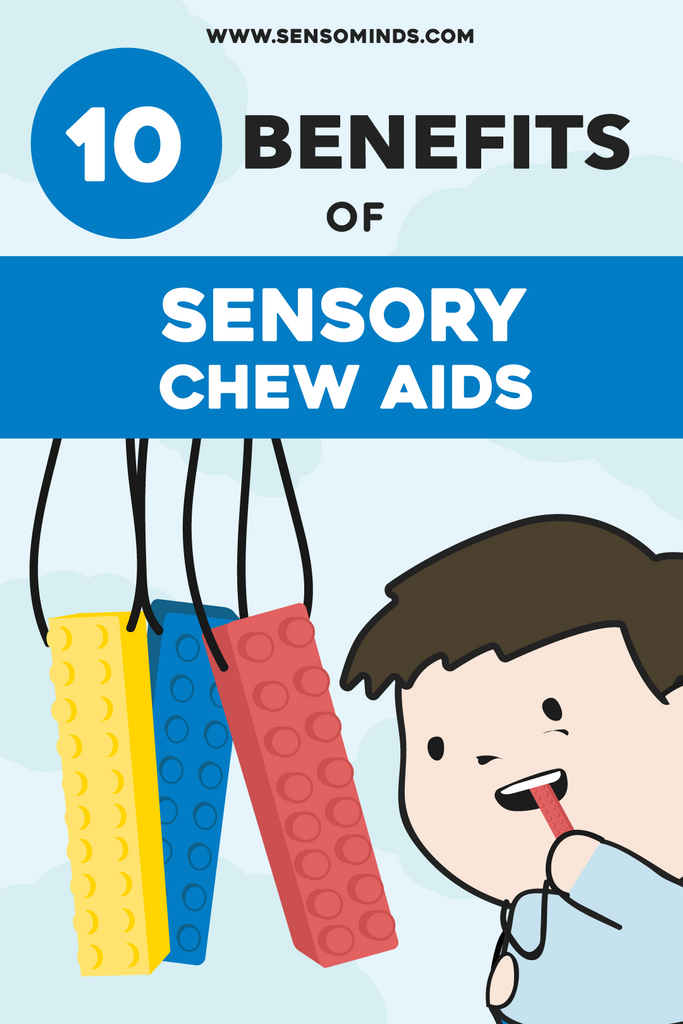I’m not hungry... I just need to chew!
The sucking reflex develops when a baby is in the womb as early as 32 weeks and is typically fully developed by 36 weeks. This sucking, as well as mouthing (and eventually chewing) has numerous benefits both in the womb as well as outside. One of our strongest sensory organs is our mouth, where we have about 10,000 sensory receptors-that’s a lot! Being that our mouth is one of the most sensory-sensitive parts of our body, sucking and chewing using sensory chew toys are extremely advantageous ways to regulate our behaviors.
Our senses are the backbone of our ability to learn and participate in our daily activities. Our sensory system is responsible for taking in information from our world, organizing and interpreting and then making a meaningful response. Everyone processes information differently. It is important to acknowledge the sensory needs of children with special needs, such as those with sensory processing disorder (SPD) or autism. Sensory chew toys are a popular tool for kids to make processing this information more manageable.
"When we see children chewing, this often indicates a child seeking input to be calmed down because he/she is most likely over stimulated."
We use our mouth to explore our world. At 18-24 months it’s normal for a baby to put things in their mouth and chew. This behavior generally decreases with time and with typical development, eventually ceases. Kids with SPD or autism are often seen to continue to chew, passed the age of 2. This is usually as a result of seeking further proprioceptive input (input to your muscles and joints). Proprioceptive input is calming & organizing. Our jaw muscles are one of our strongest muscles in our body; therefore, chewing gives us a great amount of proprioceptive feedback to our brain.
When we see children chewing, this often indicates a child seeking input to be calmed down because he/she is most likely over stimulated.
For some children with special needs, their brains are bombarded with incoming information. This often makes it difficult for a child to filter out irrelevant stimuli or information and only focus on one specific input. As a result, this causes a stress reaction in the brain, and we see an output behavior that is looking for something to calm. We very frequently see this behavior manifest as chewing inappropriately, such as on clothes, objects, or even themselves.
There are ways that we (especially as parents/caregivers and OTs) can help these children. Some examples are with sensory diets, breaks in the day, but especially sensory chew toys which provide opportunities to chew in healthy ways.
We can help children learn how to process incoming information from the world by appropriately meeting their chewing needs. Sensory chew toys allow for many positive outcomes. Today, there are a large variety of sensory chew toys available for purchasing.
Here are 10 Benefits of Sensory Chew Toys For Kids:
- Meet a sought out need: Oral sensory toys can help diminish the need to chew. This is done by providing the appropriate oral input (proprioception) that a child may be seeking.
- Improve Focus, Attention & Concentration: This can be seen in classrooms, therapy sessions as well as interacting in community activities. As a result of improved focus and concentration, you see improved motor performance and skills.
- Improve mood: Sensory chew toys help a child learn how to self soothe and calm. As a result, they feel better internally and tend to be happier. Meltdowns and tantrums decrease and more positive behaviors occur. Sensory chew toys can help when a child is feeling frustrated, overwhelmed, or bored.
- Assists with transitioning and organizing: Chewing provides proprioceptive input which is known to be calming and organizing. This can create smoother and less anxiety provoking transitions throughout the day.
- Encouraging healthy outlets: By choosing healthy chewing behaviors (by using sensory chew toys) you eliminate chewing on unsafe and inappropriate items. Children are better able to manage sensory overload as a result of getting the appropriate sensory input and therefore they are able to provide a more productive sensory response.
- Decrease social anxiety: Anxiety is common with children, especially among children who have autism. This tends to be the most common reason kids chew. By managing stress and anxiety levels through chewing, children will be less anxious and happier.
- Improves social skills. Since we know sensory chewing can decrease social anxiety and aid in children feeling more comfortable in their own bodies, we see this translate into children more relaxed in social settings and interactions.
- Provide a Sensory Filter: Sensory chew toys can help filter and organize sensory information. This helps a child better process input and then provide a more appropriate output or response.
- Strengthen Oral Motor and Facial Muscles: Sensory chew toys are beneficial for developing muscles, oral motor exploration and can even help minimize food aversions. By using sensory chew toys, children are exposed to a variety of different textures. Strengthening tongue coordination as well as jaw and lip closure through the use of sensory chew toys can help improve oral coordination of speech, eating and drinking.
- Teach us about our children: This one is my favorite! By observing our child seek out sensory chew toys, we can learn about our child's unique needs. What is causing stress or anxiety? When are they feeling overstimulated? Can we anticipate and better prepare our children for these situations?
Chewing serves a purpose and has many benefits when done appropriately using sensory chew toys. When we embrace the need to chew, we often see happier, more confident kids better equipped to take on the world!



Leave a comment: